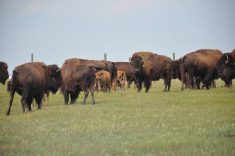Changes to Alberta’s BSE program implemented Jan. 1 should benefit farmers, especially in the spring calving season.
The Alberta program is different than the rest of the country, but hopefully other provinces may follow suit.
Provincial veterinarians in charge of Alberta’s program realized that the numbers of BSE submissions have dropped significantly, resulting in fewer points on the World Organization for Animal Health system.
This is an undesirable situation for international trade so Alberta decided to make changes to increase desirable submissions.
Read Also

Canadian Food Inspection Agency extends chronic wasting disease control program consultation deadline
Date extended for consultation period of changes to CWD program
Alberta producers don’t pay veterinary or mileage costs for BSE testing.
The main changes have been reinstating former allowable submissions.
The maximum age for almost all categories is still one month younger than nine years old, but most cattle will fit because most old cows have been culled.
There is still a requirement for ownership for 30 days, which means short keep auction market or dealer cattle do not qualify.
Calving-related deaths or those resulting in prolonged downer status do qualify. Even cows that die with a prolapsed uterus qualify again.
Veterinarians should still attempt to alleviate health conditions, such as fixing a prolapsed uterus, correcting a malpresentation or doing a caesarian section.
In cases of emphysematous calving where the veterinarian feels the health of the cow is severely compromised, the cow could be put down for humane reasons and fit the BSE program.
Cancerous eyes, lumpy jaws, mastitis and severe foot problems again qualify, but only if they have reached the stage where they are unfit for human consumption or are unable to be humanely transported.
Think of the distance to be transported and by what means when determining humane transportation.
There is a big difference between taking an older arthritic cow 50 kilometres by itself in a stock trailer to a provincial plant and loading that same cow in the front of a pot bellied trailer with other healthy cows and hauling it 800 km to a federal plant.
Your veterinarian may have to make the call on these. If you are in doubt, phone and find out.
The BSE program would like postmortems done, but frozen samples are acceptable again as long as a sample can be retrieved and the cow is the right age.
There is no longer a seven day waiting period in the case of attempted surgeries that have not gone well. They now qualify immediately if the post surgery situation looks grave.
Producers can now put down severely injured animals such as those with compound fractures and have a BSE test performed later. Where possible, producers are still expected to receive a verbal OK from their veterinarian before putting down a bull or cow.
The program would still like producers to submit samples if animals are acceptable to butcher, but they won’t be compensated because it would be considered double dipping.
In the future, the program may consider partially compensating producers for helping with the emergency slaughter of animals.
For now, producers can know that they are helping the program. As well, veterinarians can at least look at the carcass and organs to check that the meat is acceptable for human consumption.
Neurological cases such as sudden paralysis, seizure, ataxic or circling deficit that a veterinarian attributes to a neurological problem can be tested at any older age.
These qualities make it a fairly broad category so I recommend calling your veterinarian to see if the case qualifies.
As in the past, the BSE program puts veterinarians in touch with their clients. It helps vets better understand producers’ herd management and, based on the results of the post mortem, better advise a preventive course of action for the future.
For participating clinics, the BSE post mortem results tie directly into the Alberta Veterinary Surveillance Network, which monitors disease occurrence in Alberta and helps keep the province’s cattle healthier.
When performing these BSE tests, veterinarians watch for reportable and notifiable diseases.
Each province has a list of these diseases and it will vary slightly by region. The lists also change slightly over time.
Reportable diseases are those where action is taken to eradicate the problem. These often parallel federal reportable diseases, such as foot-and-mouth disease.
A recent addition was death from a toxic substance, which is any poison, including lead or arsenic, that poses a threat to animal or human health.
Provincial veterinarians help local veterinarians and producers deal with the problem and prevent it occurring in the future.
Notifiable diseases are monitored for trade purposes and to help understand their presence in Alberta.
Vets report these diseases to the provincial government and then treat them as they see fit.
However, province-wide measures may be put in place if the incidence increases. Communication may also be made to surrounding veterinarians to watch for the disease.
Overall it allows us to keep Alberta cattle healthier by working together. Diseases in this category would include Johne’s and the emerging reproductive diseases vibrio and trichomoniasis.
Every province has a slightly different approach to BSE testing and reportable diseases.
Your veterinarian is the best source for this information.














